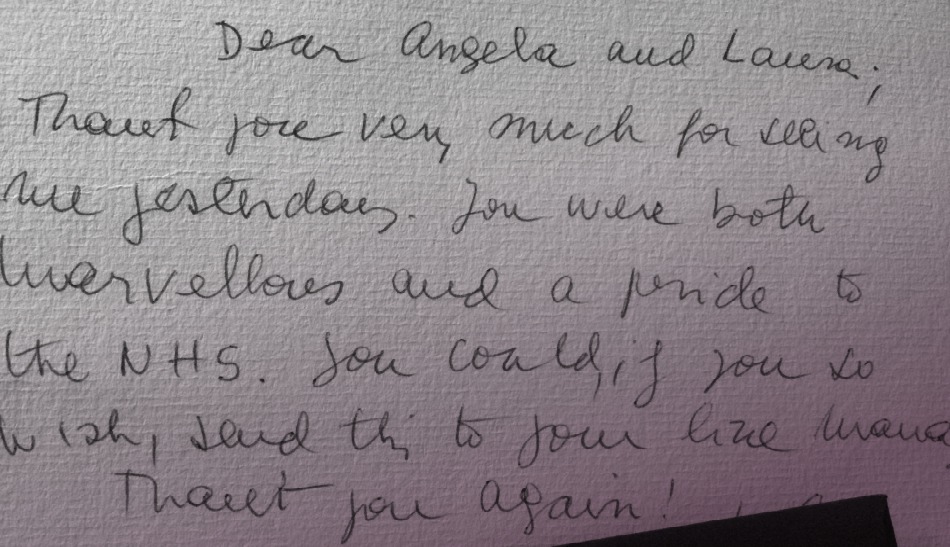Cataract & Glaucoma
The problems and connection between glaucoma and cataracts surgery
If you have glaucoma and need cataract surgery, you should explore whether you can have a pressure lowering procedure at the same time as your cataract operation. The system’s name is Phaco Plus Procedure or cataract surgery with minimally invasive glaucoma surgery (MIGS.) Ms Crawley is trained and experienced in these procedures.

I had the best experience working with Dr Crawley. I felt looked after and she took the time to get to know me. I would highly recommend her.

From the moment I met her to the moment I left, I was treated with great courtesy and kindness, and everything was explained to me in layman’s terms so I could fully understand my condition. I was immensely impressed.

“Thank you very much for seeing me yesterday, you were marvellous and a pride to the NHS”

Dear Laura,
Just a quick note to say thanks for looking after my mum Mrs M. so wonderfully. It was so good of you to take so much time and care as she was very worried about my appointment and you really made such a difference to my experience. Thank you.

Dear Angela and Laura,
Thank you very much for seeing me yesterday. You were both marvellous and a pride to the NHS. You could, if you two wish, send this to your line manager. Thank you again!

Dear Laura,
Enjoy your holiday and thanks for everything so far.
Best Wishes
Why cataract surgery and glaucoma treatment combined?
The specialist can reduce the eye pressure by 20% or more in several ways. First, by placing one or many stents in the drainage pathway inside the eye. Second, by applying a laser to the glands that produce the aqueous fluid inside the eye (endocycle photocoagulation or ECP). This can reduce the need for glaucoma drops after your cataract operation. The main risk in operating inside the eye is the risk of infection. It is helpful to treat glaucoma when you are already inside the eye removing the cataract.
Ms Crawley and her colleagues at The Western Eye Hospital at Imperial College Healthcare NHS Trust were one of the first and one of the biggest centres in the UK to offer ECP.
To not provide combined treatment for glaucoma with cataracts in one operation may be an opportunity missed. A combined treatment may improve the longer-term pressure control. It also may reduce the burden of drops for the patient who must take the treatment life-long.
Treatment
The pressure inside the eye relies on the amount of internal aqueous fluid the eye produces. It also relies on the rate at which it is drained through the eye’s internal outflow pathway. This fluid and drainage are different to your tears which are external to the eye.
Endocyclophotocoagulation (ECP) means applying a laser to the ciliary body that produces the aqueous fluid under direct endoscopic vision. Endoscopy is the technique that passes a camera into spaces inside the human body. This allows us to identify issues, however small, with certainty. It is also used by doctors who examine the stomach and intestines.
Reducing the amount of aqueous produced is like turning down the tap- reducing the inflow part of the pathway.
The specialist carries the ECP out through the same incisions used for the cataract operation and adds 20 minutes to the operation. It can be performed under the same anaesthetic used for the cataract surgery.
A micro stent, often the iStent, is a snorkel device that the specialist inserts into the channels that drain the aqueous fluid out of the eye. This is placed into the drainage angle at the end of the cataract operation and adds 20 minutes to the end of the cataract procedure.
These micro-stents consist of titanium. They are currently the smallest implants used in the human body.
They are not detectable to the naked eye. Only an ophthalmologist can visualise them by looking into the drainage channels using a goniolens.
What should I expect after combined cataract and minimally invasive glaucoma surgery?
The post-operative recovery period is like the cataract surgery alone. Yet, this involves more than one procedure. It is usual to increase the frequency of the anti-inflammatory drops after the procedure from 4 x daily to 6 x daily. You may need the drops for 6 weeks rather than 4 weeks.
Accreditations and Memberships
Related articles
Can you avoid blindness by checking for glaucoma at home?
Many of the patients who were registered blind in 2016-2017 potentially could have avoided this devastating vision loss if an eye healthcare professional picked up their glaucoma earlier. Don't be among those who rely on at home tests only to have their glaucoma fail to be detected until it's too late.
If you’re over 60 you can’t afford to wait another year for your next eye exam
Glaucoma, like diabetic retinopathy, has no symptoms in the early stages. The early stages are the golden opportunity to diagnose and treat the condition so that you never lose significant vision in your lifetime. Having a routine eye examination doesn’t hurt, is easy and doesn’t involve long waits for test results.
The one question every patient should ask about their glaucoma treatment – but doesn’t
Please, ask what your maximum eye pressures are before you start treatment and keep all copies of your medical reports. It makes managing your eye conditions much easier and much safer.

































Find us on social media